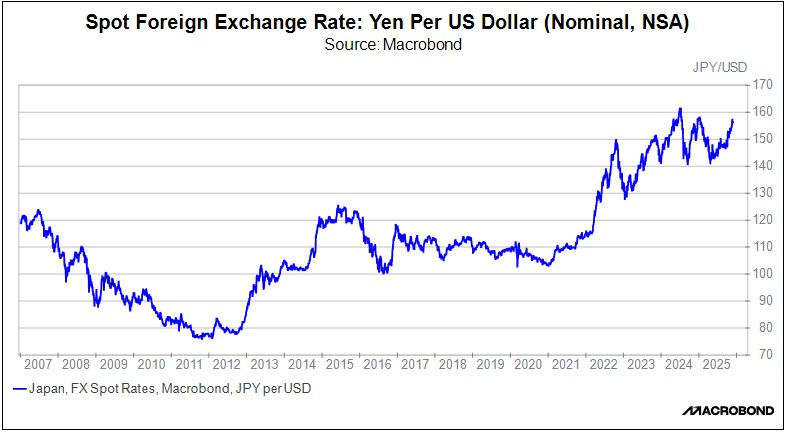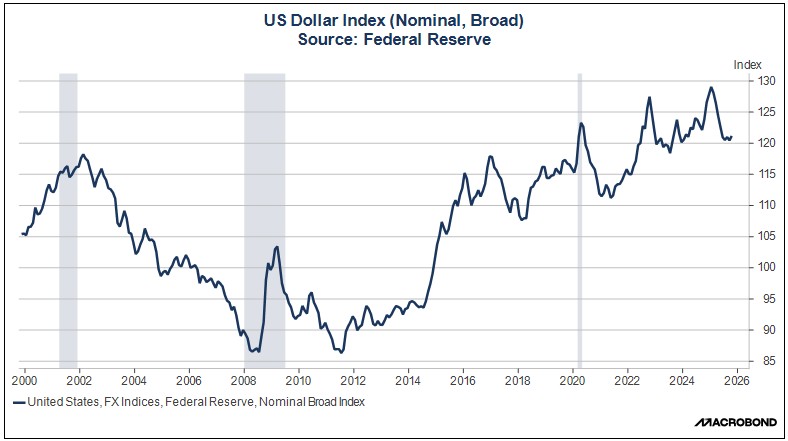by Patrick Fearon-Hernandez, CFA, and Thomas Wash
[Posted: 9:30 AM ET] | PDF
Our Comment begins with a discussion of the setbacks challenging the White House’s AI industrialization push. Next, we turn to the increasing influence of the Treasury Department over the Federal Reserve. Our global coverage provides a deeper look into the escalating tensions between Venezuela and the US, the recent stabilization in China-Japan relations, and the latest developments concerning the AUKUS security alliance. We conclude with our essential roundup of key domestic and international data releases to keep you informed.
White House AI Push: The White House has faced setbacks this week in their efforts to gain greater control over AI adoption. On Tuesday, two key initiatives were halted: a bid to expand federal influence by prioritizing American AI firms for contracts, and an attempt to preempt state-level regulation of AI development. Compounding this, a recent Microsoft report revealed that the pace of AI adoption is significantly slower than anticipated. These setbacks represent the obstacles hindering efforts to integrate AI more broadly into the economy.
- The annual defense policy bill currently moving through Congress includes two key AI-related measures. The first is the GAIN AI Act, which would mandate that US chipmakers prioritize domestic customers over China and other countries subject to US arms embargoes when allocating advanced AI chips. The second measure is a provision that would preempt states from passing their own legislation to regulate AI.
- The inability of these provisions to pass into law is a clear setback for the White House’s efforts to create conditions favoring domestic reindustrialization. The administration had hoped to ensure America’s lead by preventing technology firms from prioritizing sales to rivals over US customers. Concurrently, it aimed to prevent state-level regulation from interfering with the industry’s planned expansion.
- On the corporate side, there are mounting signs that AI industrialization may be losing momentum. A recent report indicated that the slow pace of AI adoption has forced Microsoft to reduce sales quotas for certain AI products after staff missed previous targets. Meanwhile, Morgan Stanley announced that it is exploring options to offload some of its data center debt through off-balance-sheet financing structures.
- While government support for the AI sector is expected to continue, we anticipate significant political resistance from both corporations and voters. This pushback could significantly slow the rate of AI adoption across the economy, creating potential volatility within the high-flying tech sector. Although we believe key AI companies retain substantial growth potential, this increased regulatory uncertainty warrants greater portfolio diversification as a necessary risk management strategy.
More Fed Scrutiny: US Treasury Secretary Scott Bessent is actively trying to reshape the Federal Reserve. On Wednesday, Bessent announced a specific plan to push for a residency requirement for the next regional Fed presidents, a reform he argues will better connect the central bank to local districts. This move, combined with Bessent’s pivotal role in selecting the next Fed chair, signals a broader trend toward increased Treasury influence over the historically independent central bank.
- This desire for greater control taps into a long-standing tension, particularly in the period before the 1951 Fed-Treasury Accord. During this time, the Fed was not technically under the Treasury but was compelled to peg interest rates on government debt to keep financing costs low, effectively ceding control over monetary policy. The formal separation of these functions was established after a public dispute over inflation between then Fed Chair Thomas B. McCabe and President Harry S. Truman.
- Even after achieving formal autonomy from the Treasury, the Federal Reserve remained a target for presidential influence. Notable examples include Lyndon B. Johnson’s clashes with Fed Chair William McChesney Martin Jr. and Richard Nixon’s pressure on Arthur Burns. This dynamic only changed when Paul Volcker’s resolutely hawkish stance finally tamed inflation. His success did not just lower inflation; it vindicated the principle of an independent Fed, making political interference far costlier for future presidents.
- This trend has become more apparent today. The Federal Reserve’s loss of credibility, following the inflation surge brought on by the pandemic, continues to generate market skepticism. While the central bank has made headway in taming inflation from its 2022 peak, major concerns persist that it could prematurely abandon its price stability mandate to prioritize maximum employment.
- These concerns have manifested in the bond market, where investors remain skeptical of the Fed’s commitment to maintaining restrictive policy long enough to fully curb inflation. This skepticism is clearly evident in the 10-Year Treasury yield, which has remained stubbornly elevated, refusing to fall below its 2024 lows despite the Fed having lowered its benchmark interest rate by 100 basis points this year.
- Bond investors have reportedly already informed Treasury Secretary Bessent of their opposition to Kevin Hassett, citing his close ties to the White House as a primary concern. While the impact on the nomination is uncertain, this resistance may bolster the chances of former Fed Governor Kevin Warsh, who is seen as a centrist alternative to Hassett and a compromise to the market’s clear preference for current Fed Governor Christopher Waller.
Maduro Stepping Down: Brazilian billionaire Joesley Batista travelled to Venezuela to privately urge President Nicolás Maduro to step down, which coincided with aggressive US counternarcotics pressure on the regime. While Maduro sought to de-escalate with an offer of resignation in exchange for amnesty, the White House reportedly rejected the terms. We view this escalating US pressure as part of a longer-term strategy aimed at containing China’s expanding influence in South America.
Japan-China Tensions Cool: Japanese Prime Minister Sanae Takaichi has attempted to appease Beijing by reiterating Japan’s conventional stance on Taiwan. This move follows a significant diplomatic rift triggered by Takaichi’s earlier remarks that a Chinese military takeover of Taiwan could constitute a “survival-threatening situation” for Japan. While this repetition of the official position is expected to temporarily cool tensions, the underlying security concerns she raised suggest that the possibility of conflict remains elevated.
AUKUS Confirmed: Australian Prime Minister Anthony Albanese announced the US will maintain its commitment to the AUKUS security pact with the UK. His remarks followed the conclusion of the White House’s six-month review of the agreement’s nuclear powered submarine sale (Pillar 1). The pact’s continuation clears the way for the three nations to proceed with building crucial defense capabilities and enhance interoperability in the Indo-Pacific.








